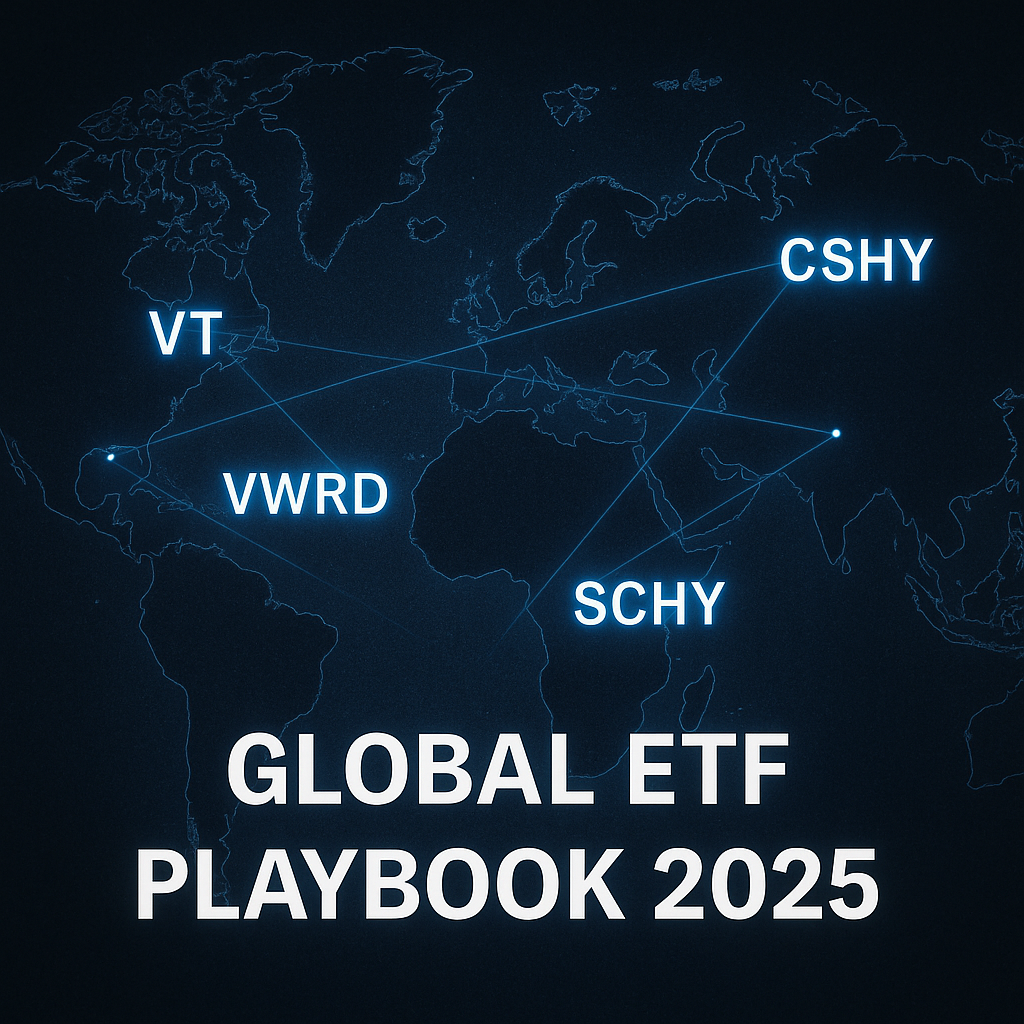1 | Why Offshore ETFs Matter in 2025
For U.S. citizens living abroad, the Passive Foreign Investment Company (PFIC) regime can turn ordinary non-U.S. mutual funds into a tax nightmare (37 % “excess-distribution” plus interest). The workaround? Hold exchange-traded funds that trade on a U.S. exchange (NYSE / NASDAQ) or, if you’ve surrendered U.S. tax residency, use Irish-domiciled UCITS ETFs that avoid PFIC for non-U.S. persons and slash dividend withholding from 30 % to 15 %.
2 | Non-PFIC ETFs You Can Buy on NYSE (Still U.S. Tax Resident)
| Ticker | Index | TER | Dividend Yield | Why It Beats PFIC |
|---|---|---|---|---|
| VT | FTSE Global All-Cap | 0.07 % | 2.1 % | One-ticket global; 0 % PFIC risk |
| SCHY | Dow Jones Dividends ex-U.S. | 0.14 % | 4.9 % | High yield w/ foreign tax creditable |
| SCHF | FTSE Developed ex-U.S. | 0.06 % | 2.4 % | Low TER, paired with VOO for tilt |
| BNDX | Bloomberg Global Agg ex-USD (Hedged) | 0.07 % | 2.6 % | Hedged bond sleeve |
Tip: Hold these inside a U.S. brokerage (IBKR, Charles Schwab) even while abroad; Form 1099 covers all reporting.
3 | Irish-Domiciled UCITS ETFs (After You Break U.S. Tax Residency)
| Ticker | Exchange | Index | TER | WHT on U.S. Div. |
|---|---|---|---|---|
| CSPX | LSE | S&P 500 | 0.07 % | 15 % (Irish treaty) |
| VWRD | LSE | FTSE All-World | 0.22 % | 15 % |
| IQQQ | Xetra | NASDAQ-100 | 0.30 % | 15 % |
| AGGG | LSE | Bloomberg Global Agg Bond | 0.10 % | n/a (bond) |
Withholding-Tax Drag: CSPX receives S&P 500 dividends net 15 %, compared with 30 % for a Cayman-domiciled ETF—worth ~40 bp alpha per year.
4 | Brokerage On-Boarding Checklist (2025 Updates)
- Interactive Brokers Global – Accepts 200 + passports; updated MiFID II requirements ask for annual KID acknowledgement.
- TradeStation Global (UK) – Uses IBKR clearing; cheaper FX conversion (0.25 %).
- Saxo Investor – Adds “Fractional ETF” trading Q3 2025 (min €100).
- Swissquote Intl. – Offers Euroclear Bank Belgium custody for Tier-1 segregation.
5 | Withholding-Tax Math (Example: $1 M Portfolio, 2 % Yield)
| Structure | Gross Dividend | WHT to U.S. | Net | Drag vs. U.S.-domiciled ETF |
|---|---|---|---|---|
| U.S. ETF (VT) | $20,000 | $0 | $20,000 | Baseline |
| Irish UCITS (VWRD) | $20,000 | $3,000 (15 %) | $17,000 | –0.30 % p.a. |
| Cayman ETF | $20,000 | $6,000 (30 %) | $14,000 | –0.60 % p.a. |
6 | PFIC “Danger Zone” Checklist
- Any fund not listed on a U.S. exchange and organised outside the U.S.
- Look for words “SICAV”, “OEIC”, “ICAV”, “PLC” in the prospectus.
- If unavoidable, elect § 1296 MTM regime the first year; avoids interest‐charge method.
7 | Building a Globally Efficient 3-Fund Portfolio
| Sleeve | Resident U.S. Expat | Non-U.S. Expat (Renounced) |
|---|---|---|
| Global Equity | VT (100 %) | VWRD (60 %) + CSPX (40 %) |
| Bonds | BNDX (50 %) | AGGG (50 %) |
| Dividend Tilt | SCHY (15 %) | IDVY (15 %) |
Rebalance annually; use FX-aware rebalancing inside IBKR’s GlobalAnalyst tool.
8 | Future Trends (2025 – 2028)
- SEC Cross-Listing Framework – Rumoured to green-light direct cross-list of UCITS on NYSE by 2027.
- Tokenised ETF Shares – Franklin Templeton experimenting with on-chain share registry; could cut custody fees by 40 %.
- Asia-Pacific Treaty Shake-Ups – Singapore exploring 0 % WHT for Irish UCITS routed via SGX.
9 | Step-by-Step Account Opening (IBKR Example)
- Residence proof – Utility bill within 60 days.
- Tax forms – W-9 (U.S. person) or W-8BEN / CRS (non-U.S.).
- Base currency – Pick USD even abroad; avoids FX “ghost P/L.”
- Funding – Wise USD wire (< $5).
- Trade ticket – Use SMART routing; set AON for small Irish UCITS to avoid partial fills.
10 | Bottom Line
Offshore ETFs let expats dodge PFIC, trim withholding tax, and keep global exposure simple. Stick with NYSE-listed tickers until you truly exit U.S. tax residency; then pivot to Irish UCITS. Pair low-cost brokerage access with yearly tax checks, and your long-horizon wealth compounds without silent leaks.
